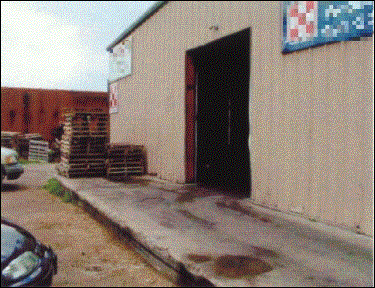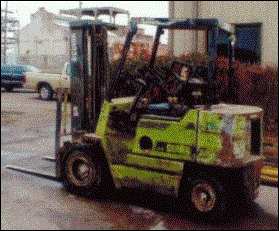A 67-year old maintenance worker for a feed and seed retail store was killed when he was crushed by a forklift that ran off a loading dock and overturned onto him in Oklahoma

SUMMARY
A 67-year old maintenance worker died on February 28, 2000 from multiple crushing injuries received when he was pinned by a forklift that ran off a loading dock and overturned onto him. The victim was operating the forklift on a low-level loading dock that was not sloped. He dismounted the forklift to remove an empty pallet that was apparently jammed on the forks. He did not take the forklift out of gear, lower the forks, or set the hand brake before getting off it. As he attempted to remove the pallet, the forklift began to move in reverse, and the victim ran after it to try to prevent it from rolling off the dock. As the worker attempted to climb onto the vehicle, the rear left wheel rolled off the dock and the forklift overturned. The worker was crushed beneath the forklift’s overhead guard.
FACE investigators concluded that to prevent similar occurrences, employers should:
- Develop and implement a written program that includes policies regarding the use and safe operation of forklifts.
- Ensure that all employees receive at least some awareness training regarding the hazards of unfamiliar equipment, such as forklifts, and an understanding of the training and authorization requirements for operation of the equipment.
 |
 |
| Figure 1. Loading Dock | Figure 2. Forklift the Victim was Using |
INTRODUCTION
A 67-year old maintenance worker died on February 28, 2000 from multiple crushing injuries received when he was crushed by a forklift that had rolled off a loading dock and overturned onto him. OKFACE investigators reviewed the Occupational Safety and Health Administration (OSHA) Fatality/Catastrophe Report, the death certificate, and the medical examiner’s report. A site visit was conducted on April 14, 2000; OKFACE investigators interviewed the company owner and the manager.
The victim worked for a feed and seed retail company that had been in business with current ownership and management for five years. The company employed 15 people. The deceased worker had worked at the store for 20 days prior to the day of the incident. On his employment application, the deceased worker had indicated that he was a forklift operator and had considerable experience with machinery. However, the current employer could not provide objective evidence that the deceased worker had forklift training.
The company had a written safety program that was compiled and provided by the employee leasing company, but contractor management personnel managed the program. All new employees received orientation that covered safety information included in the written program. Prior to the incident, the materials did not include a written forklift program; however, the local vocational-technical school had initiated a forklift training program six months earlier. Operators received classroom and hands-on instruction, and their performance was evaluated by written examination and demonstration. The company required operator training and certification for all personnel assigned to operate the forklift and a small front-end loader used at the facility. The deceased was reportedly the only worker at the site that had not participated in the operator training and certification program, and managers stated that he had been instructed not to operate the equipment. The worker had been hired to drive a spreader truck.
INVESTIGATION
On the day of the fatal incident, the weather was cool and clear, and the working surfaces were dry. The deceased worker arrived for work at approximately 8:00 a.m. While waiting for customer orders, he was moving an empty pallet to the north end of the loading dock. The concrete loading dock, which was on the west exterior of the building, was approximately 8 feet wide, 65 feet long and 10 inches tall. It was not sloped. The worker was using a 1991 model 5000-pound capacity Clark BPX 25E propane-powered forklift, which weighed 8830 pounds, to move the pallet. The pallet became jammed on the forks, and the victim dismounted the forklift to remove it. The forklift was positioned at a slight angle and approximately two feet away from the edge of the dock with the forks elevated approximately five feet. When he dismounted, the victim did not set the hand brake or lower the forks, and he left the forklift in reverse gear. As he was attempting to dislodge the pallet, the forklift began to roll backward toward the edge of the dock, and co-workers who witnessed the event called out to alert him. He immediately jumped off the loading dock to the ground and ran alongside the forklift toward the operator’s seat in an attempt to stop the vehicle before it rolled off the dock. As he tried to climb onto the forklift to press the brake, the rear left tire rolled off the edge of the dock causing the forklift to tip toward the operator. He was struck by the forklift and fell face down onto the gravel drive. The overhead guard came to rest across his upper back. The forklift did not fall completely off the loading dock; the left front wheel remained on the dock.
The manager immediately called 911, and the fire department, located just two blocks from the site, responded in approximately five minutes. Fire fighters used an Amkus tool, commonly known as the “jaws of life,” to lift the truck and then extracted the victim. The victim was transported to the community hospital within 15 minutes where he was pronounced dead on arrival.
CAUSE OF DEATH
The Medical Examiner listed the cause of death as multiple crushing injuries.
RECOMMENDATIONS
Recommendation #1: Employers should develop and implement a written program that includes policies regarding the use and safe operation of forklifts.
Discussion: OSHA regulations and manufacturer operating manuals provide guidelines for the safe operation of a forklift and other powered industrial vehicles that should be incorporated into a formal program. Additionally, the employer should establish written training and use authorization policies that should be clearly communicated to all personnel. OSHA regulations require that the forks be fully lowered, controls neutralized, and the brakes set to prevent movement of a forklift whenever the operator is dismounted but near the forklift. In addition, operators are required to be trained, licensed, and evaluated periodically. The establishment and implementation of a written powered industrial vehicle program may have emphasized and evidenced management’s commitment to safety and provided a mechanism for better communicating the policies and practices to affected personnel.
Recommendation #2: Employers should ensure that all employees receive at least some awareness training regarding the hazards of unfamiliar equipment, such as forklifts, and an understanding of the training and authorization requirements for operation of the equipment.
Discussion: The worker reportedly disregarded instructions to not operate the forklift. The fact that he assumed he could operate the vehicle safely but failed to do so may indicate a lack of understanding of the hazards and controls associated with using the forklift and a lack of appreciation for the instructions or the gravity of the instructions that he apparently violated. Adequate introductory training regarding the equipment and safety policies and practice in place may prevent a similar occurrence.
REFERENCES
- 29 CFR 1910.178, Powered Industrial Trucks
- NIOSH Alert, Preventing Injuries and Deaths of Workers Who Operate or Work Near Forklifts, DHHS (NIOSH) Publication Number 2000-112, December 1999. Available online: https://www.cdc.gov/niosh/docs/2000-112/ (Link updated 4/13/2015)
The Oklahoma Fatality Assessment and Control Evaluation (OKFACE) is an occupational fatality surveillance project to determine the epidemiology of all fatal work-related injuries and identify and recommen prevention strategies. FACE is a research program of the National Institute for Occupational Safety and Health (NIOSH), Division of Safety Research.
These fatality investigations serve to prevent fatal work-related injuries in the future by studying the work environment, the worker, the task the worker was performing, the tools the worker was using, the energy exchange resulting in injury, and the role of management in controlling how these factors interact.
To contact Oklahoma State FACE program personnel regarding State-based FACE reports, please use information listed on the Contact Sheet on the NIOSH FACE web site Please contact In-house FACE program personnel regarding In-house FACE reports and to gain assistance when State-FACE program personnel cannot be reached.
Back to NIOSH FACE Web
